Many birders in pursuit of passerine quarry travel to offshore islands or remote headlands where a shortage of cover can, in season, give the erstwhile hunter better odds of finding migrants than on the mainland, which reduces the chances considerably by virtue of its vastness! But one can apply the same isolation concept to green areas within a hostile surround, replacing islands and seascape with parks and urban sprawl.

Canary Wharf at night (Photo: flickr user Larsz)
Between 2001 and 2006, Andrew Middleton, Dusty Gedge and Ken Murray were the principal players in what would prove to be a ground-breaking project for urban London. Monitoring the Canary Wharf complex of green spaces has to date involved more than 3,000 man-hours, and no fewer than 37 passerine migrant species have been recorded, of which more than 50% are nationally rare or locally scarce. In addition, two out of three other races/species recorded are potential firsts for Western Europe. To date I am not aware of any other urban comparison to this phenomenon in Europe.
This project has been driven by an incidence of migrant passerines that has sometimes been on a scale comparable to a coastal observatory, all in a totally alien six-acre environment. The results to date were only achieved through total commitment and site sensitivity by the observers concerned, with the support of Canary Wharf Group plc, and the sponsorship and encouragement of HSBC.

One of the tiny green areas within the Canary Wharf complex (Photo: Ken Murray)
The story began in autumn 2000 when I was driving home late one evening and I saw the 840-ft Canary Wharf Tower, ignited by white light and looming out of the trees some 12 miles distant. This inspired me to consider whether perhaps the odd migrant might be 'resting' at the foot of this steel and glass corporate lighthouse. I mused to my wife, "we must go and pick up a few bits tomorrow; how about the Canary Wharf shopping mall?" When we arrived the following morning we parked in the underground car park, took the lift to the mall, then the escalator to a ground-level glass trapezium. To my surprise, this overlooked a tree-lined square overshadowed by London's own cloud-piercing piece of Manhattan, No.1 Canada Square! It was whilst I craned my neck skywards that I espied the definitive zip movement that would change my life forever. The speed of it could only belong to a trans-Saharan; it was followed by another, then another disappearing into the Chestnuts. This is no cemetery I thought: this is the UK's first inland lighthouse migrant trap!
That first autumn was covered initially by myself, casually logging Willow Warbler, Chiffchaff, Blackcap, and what took it into a higher gear: Regulus ignicapillus — not one, but two Firecrests. The alarm bells were now ringing! During this phase of construction — 2000/2004 — the noise levels were deafening: a concerto of pile drivers, drills, hammers, oxyacetylene, squealing brakes; and yet even this cacophony couldn't eclipse the Phylloscopus 'tsooeet' or Sylvia 'tac'.
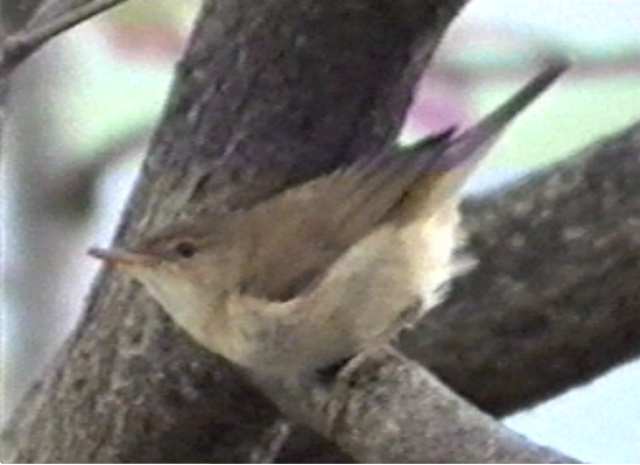
Blyth's Reed Warbler (Grab: Andrew Middleton)
2001 saw the site hitting the mercury with Melodious Warbler, seen well by three observers on 18th August and the well-documented post-9/11 Blyth's Reed Warbler — the first inland/London record! — on October 5th. News of the latter bird was not released, following consultation with the site management who felt that it would be inappropriate as security could be compromised. Such was the concern that Andrew Middleton and myself were issued with photo ID permits which theoretically allowed us to monitor the site without intervention from security.
2002 was covered between 21st April and 4th November, during which time thirteen species of migrant were recorded. These included Icterine Warbler on 28th July (one observer), then a leaf green, yellow wing-barred Phylloscopus with a buff wash to the vent on the 31st, which disappeared without its ID being clinched. A Booted Warbler was present on 6th October (the first inland and London record), a solitary individual which showed extremely well, albeit briefly, at ground level about eight feet away before disappearing into the canopy; again there was just one observer. A particular highlight was the occurrence of nine migrants of seven species crammed into a small, open, wendy-house-sized tree, interacting like notes up and down on a music scale, as I stood barely eight feet away: totally bizarre! Perhaps a reaction to myself and the entrapment factor.
2003 monitoring started on 19th April and continued to 5th November, beginning with a single migrant and ending with the same. Peaks in spring were the last week in April and first week in May, and in the autumn 15th–22nd September, with maximum counts of around 25 birds for each period. Highlights were four Wood Warblers and two Pied Flycatchers in the crown of a single tree. On one occasion a woman was sitting on park bench reading a paperback, oblivious to a Reed Warbler frozen barely a metre away on an open Chestnut stem — both were still there 15 minutes later. Another memorable sighting was of a tall, suited city gent chatting on his mobile with one hand, inhaling a cigarette with the other, looking skywards, with a Sedge Warbler sandwiched on a bare paving stone between his '10 to 2' feet, no doubt wondering 'where am I, and what am I doing here?'

Sedge Warbler (Photo: Ken Murray)
Other less pedestrian sightings were a small, buffy, streaked Locustella first reported on 6th October and last seen scuttling away from AM and KM's respective toes on 9th October; and a probable Great Snipe on 10th October arrowing through the trees and creasing over the heads of a couple of hard-hatted workmen lunching on a park bench, before dropping low into adjacent shrubbery (another was reported northeast on the same day). Also seen briefly later that afternoon was a Barred Warbler flying low into cover and last seen on the 16th. On the 15th a 5-inch bird with brown upperparts, pale underparts, and 'long pink legs' was seen running through the ground cover, then on the 17th a delta-brown-backed bird shot from underfoot like an arrowhead disappearing into cover, never to be seen again. The mind boggles!
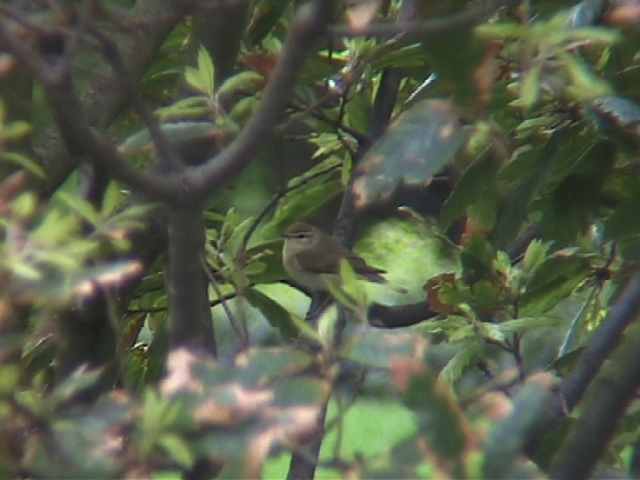
Phylloscopus sp. (Photo: Ken Murray)
The following year, 2004, was even more remarkable, possibly due to an increase in 'white light' output. On 1st May a small drab Phylloscopus with a strident 'unknown' call was seen by three observers, filmed, sonogrammed and is being researched at present: tristis Chiffchaff is a strong candidate. A week later on the 8th I filmed and 'grabbed' a putative Eastern Willow Warbler Phylloscopus trochillus yakutensis, probably the most amazing brown warbler that I have ever seen, putting Radde's and Dusky Warbler deep in the shade. Unfortunately, like so many of the migrants that occur, its appearance was all too brief.
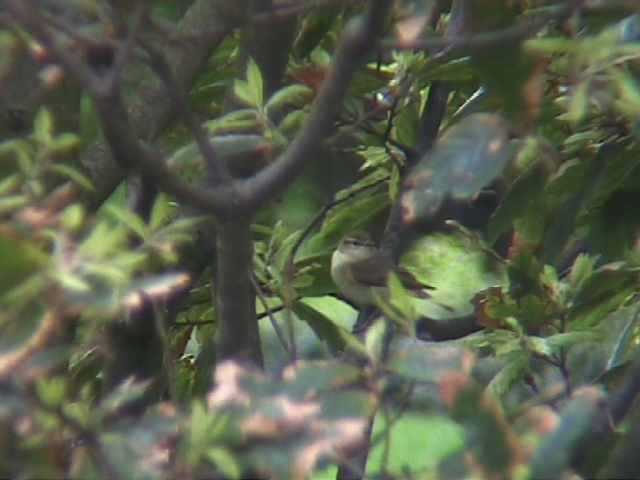
Phylloscopus sp. (Photo: Ken Murray)
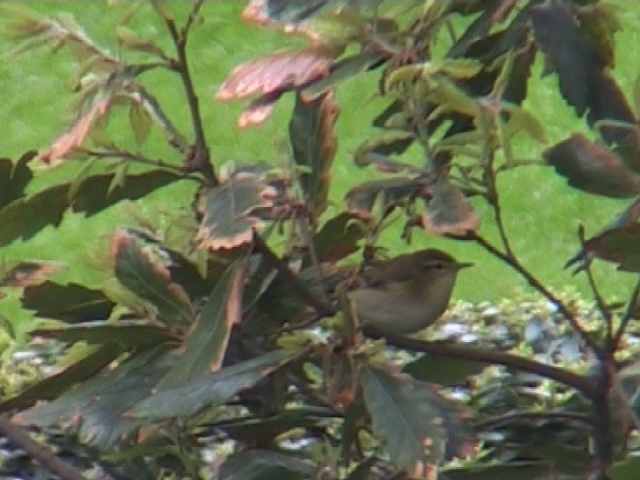
Phylloscopus sp. (Photo: Ken Murray)
If the spring was to raise expectations then nothing could have prepared us for the 'fall'. Pied Flycatcher on 4th August was the precursor to an unimaginable sequence of scarce and rare migrants to grace the steel and glass portals of Canary Wharf. On Sunday 15th August, after three hours of dogged hunting, an elusive straw-yellow and white acro, which gave indications of being a possible immature Aquatic Warbler, stared down at me from the top of a 25-ft Lime tree. Saturday 21st opened up with a 30-bird fall, including Wryneck (found by Dusty Gedge) 'tongue-flicking' invertebrates by a busy pedestrian walkway and the site's second Blyth's Reed Warbler in the crown of an adjacent tree! A second Wryneck occurred on 3rd September and was followed by a Whinchat on 9th September, Common Redstart on 10th September and Dusty Gedge's site-defining Red-backed Shrike sitting atop the tallest stem of a 40-ft Oak looking down on bright red double-decker buses screeching by, whilst being framed in the shadow of the towering 650-ft corporate Citigroup HQ — a sight so incongruous to all present that it almost defied belief! These were followed by Firecrest, Marsh Warbler and the site's 3rd Blyth's Reed on the 11th, an Icterine Warbler on the 12th, and finally Andrew Middleton's incredible Grasshopper Warbler on the 18th. The latter showed up for a photo shoot exposed on a black marble plinth giving a sunlit mirror image performance...simply jaw-dropping.
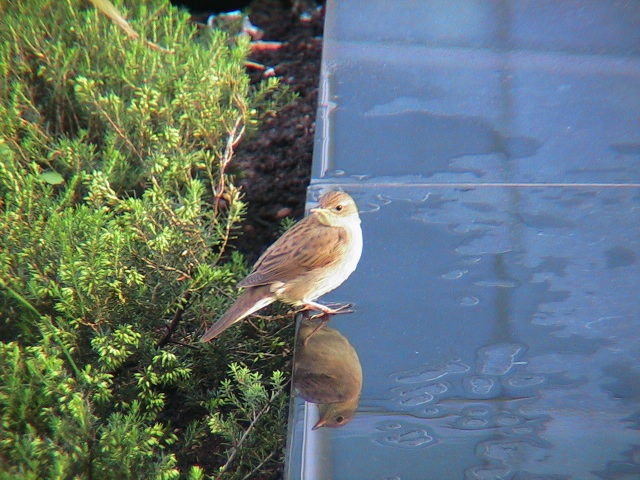
Grasshopper Warbler (Photo: Ken Murray)
2005 was greeted with much anticipation, as any matching or improving on 2004 would have been adrenalin-pumping to say the very least. However the spring started very slowly in stark contrast to 2004, with volume down around 50%: even more remarkable when you consider that the observer coverage had increased by about 40%!
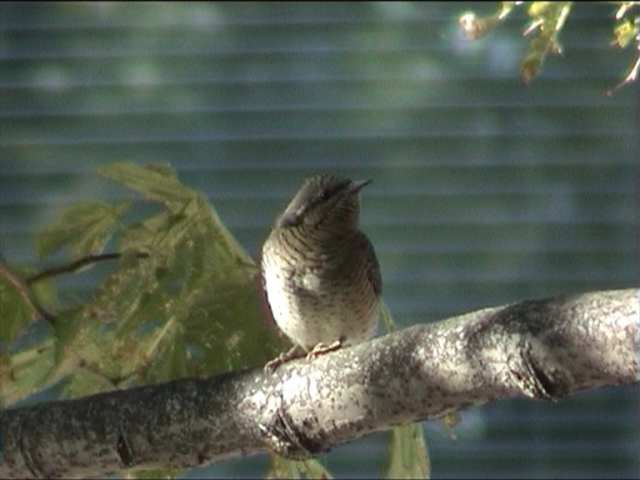
Wryneck (Photo: Andrew Middleton)
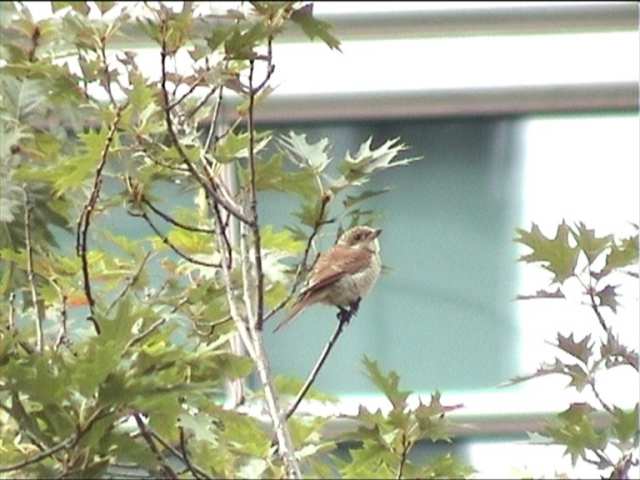
Red-backed Shrike (Photo: Andrew Middleton)
Initially this was put down to a variables glitch and we hoped that the autumn migration, which was always the busiest period, would prevail and provide the impetus for all concerned. It was not to be; nevertheless the scarce/rare migrants ratio compared well against the volume for the year. Firecrest was the leading light that kicked the autumn off on 16th August, along with a supporting cast of regular migrants that included Chiffchaff, Willow, Garden, Reed and Sedge Warblers, as well as Blackcap, Common and Lesser Whitethroat.
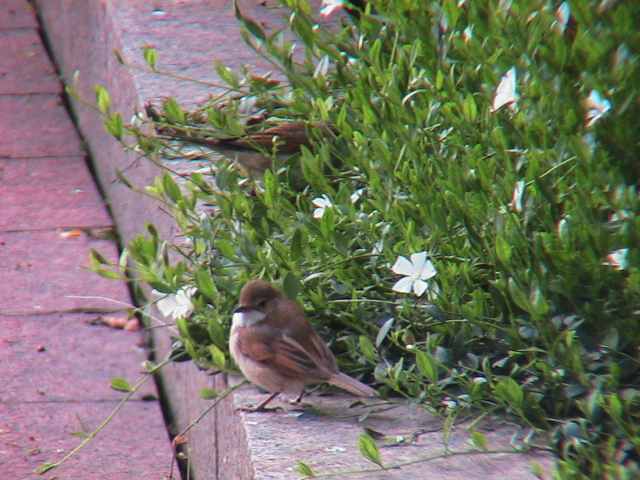
Common Whitethroat (Photo: Ken Murray)
On 30th August I had a split-second view, about 10 feet away, of an almost certain, strongly-eye-striped Paddyfield Warbler. A further hour and more of searching revealed nothing. It would have to be another one that got away. The following day Andy Middleton had the site's 3rd Icterine Warbler. On 11th September a controversial unstreaked Acrocephalus sp. was found in Canada Square. It sported a bevelled, straight or rounded tail (posture dependent), and in some lights a dark eyestripe contrasting against a pale supercillium (though in other light less so); identification was not helped by the fact that it was invariably seen high in the canopy. It was filmed, and the consensus on the grabs taken was suggestive of Paddyfield Warbler.

Acrocephalus sp. (Grab: Ken Murray)
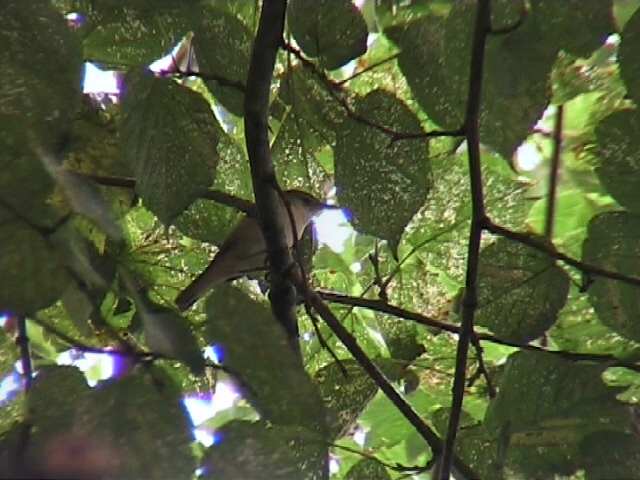
Acrocephalus sp. (Grab: Ken Murray)
The rest of the month was relatively quiet until 5th October, when the site's second Firecrest of the year turned up, possibly coinciding with a fall of 33 at Cape Clear, Ireland. This was followed by a Woodcock found stunned outside Citigroup on 18th then, totally unexpected and to the observer's amazement, Andy Middleton heard a Cetti's Warbler singing stridently on the 21st. This was definitely not on anyone's radar! I managed to obtain, with great difficulty, a short film burst from which this grab was taken whilst workmen eight feet away were digging up the adjacent walkway.
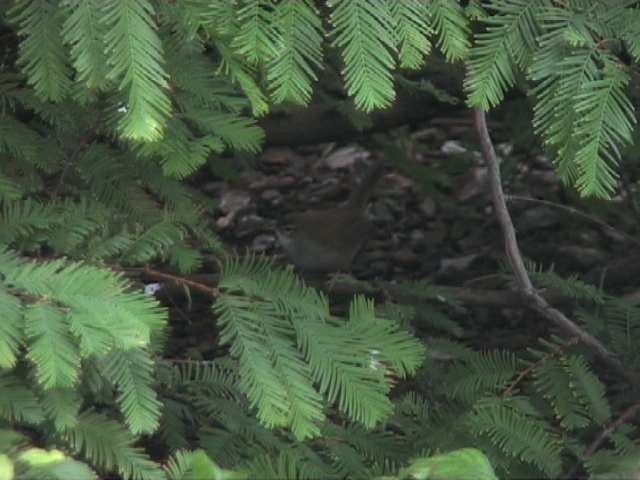
Cetti's Warbler (Grab: Ken Murray)
The spring of 2006 was almost but not quite a repeat of the previous year, except for the site's earliest Firecrest on the 1st May and the first-ever spring record of Common Redstart on the 4th. All the required variables were there except for one: the all-important weather, something we haven't quite got under control yet! The spring at best represents a small window of opportunity, from a site historical perspective perhaps three weeks. Unfortunately, during this period low air temperature dominated, which in turn delayed the leafing, denying our VIPs (very important passerines) food and shelter.
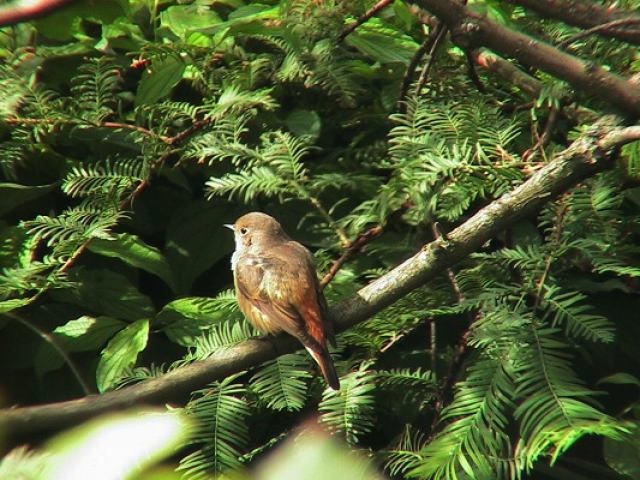
Redstart (Photo: Ken Murray)
Autumn monitoring started on 4th August with three Willow Warblers and a Sedge Warbler; a modest haul to whet the appetite for the coming months. However, this abruptly changed on 9th August when a small bland-faced non-Phylloscopus warbler appeared on several occasions, high in the canopy and showing features normally attributable to Booted Warbler. Unfortunately for all concerned, this could only be logged as a 'highly probable'. Later on that morning a probable immature/female Common Redstart was glimpsed for a nanosecond; but when seen the following day, albeit briefly, on three occasions it was positively identified as a Nightingale sp. All the salient points were noted except the crucial length of the first primary relative to the primary coverts, which separates Common from Thrush Nightingale. However, 'cosmetically' it alluded strongly to the latter; if proved to be the former it would constitute the first urban London record and the closest to Berkeley Square in a very long time. If it was a Thrush Nightingale, the record would be the first inland and earliest national record (though one was subsequently caught and photographed on Salisbury Plain on August 9th 2008). The separation will probably never be 'committee resolved'; however, the bird had a 'barrel' of white undertail coverts almost reaching the tip of a closed cocked tail, in which no hint of rufous was observed; flesh pink legs; a pale eye ring; a contrasting pale throat bordering a dark wash over the entire breast down to the belly; and grey-brown upperparts against a warm brown panel to the primary/secondaries only — which can be indicative of Thrush Nightingale.
It is sobering to consider that in three years Woodcock, Cetti's Warbler, Wryneck, Firecrest, Whinchat, Common Redstart, Barred Warbler, probable Great Snipe, Paddyfield Warbler and Thrush Nightingale — to name but a few — have all occurred within a 10-foot radius of cover surrounded by 500-foot glass and steel towers!
Following on from the 'Glorious 9th', the rest of the month was dominated by unsettled weather fronts from the west which reduced movement to a trickle, although conditions picked up within the first week of September. The ensuing old moon with clear nights had given the kiss of death to any meaningful volume. I'm afraid the towers with all their light cannot compete with the unfettered sky: we are currently praying for cloud cover as I speak.
An update on September 16th proved to be quite depressing for all concerned: two Willow Warblers and a Chiffchaff was the day's three-hour tally in what should have been reasonable conditions for a double-figure return at individual green areas, let alone in total within the estate. Observations on the day excluded Cranefly from the log. This invertebrate plays a big part in sustaining migrants during their stay and, that being the case, might go part of the way in explaining the dearth of autumn migrants. We shall certainly follow up Cranefly sightings for the rest of the campaign.
Things hotted up on the 20th when half a dozen Willow/Chaffs turned up with Lesser Whitethroat, Goldcrest and a large warbler sp. in Canada Square. Unfortunately, the latter was disturbed by a passer-by. The following day, the 21st, showed a 50% increase, including the site's only Spotted Flycatcher for the year; then on the 25th just outside the area, at East India Dock, Andy Middleton found a two-day Barred Warbler, which was well attended by many observers. Although not light-related, at 11:20am on the 26th I was presented with a totally jaw-dropping sight, when out of a warm, still, blue sky, three Common Buzzards in line drifted south creasing the 400-ft towers of Jubilee Park.
Sunday 1st October opened with a much-hoped-for revival, when the autumn's first two Firecrests appeared with one singing in concert with an accompanying Chiffchaff...another false dawn? Apart from the odd Blackcap and Chiffchaff, October appeared fairly quiet until the 28th, when an extremely odd-looking, almost confiding thrush was found by KM and AM, at times looking like a hybrid Redwing/Mistle Thrush. Subsequent research by Dr Charles Fentiman has suggested the possibility of the central Asian race of Song Thrush natalia; this taxon is not recognised by all mainstream literature, but when compared to overwintering Song Thrushes in the UAE which probably originate from the North East — i.e. Central Asia — the images are strikingly comparable.
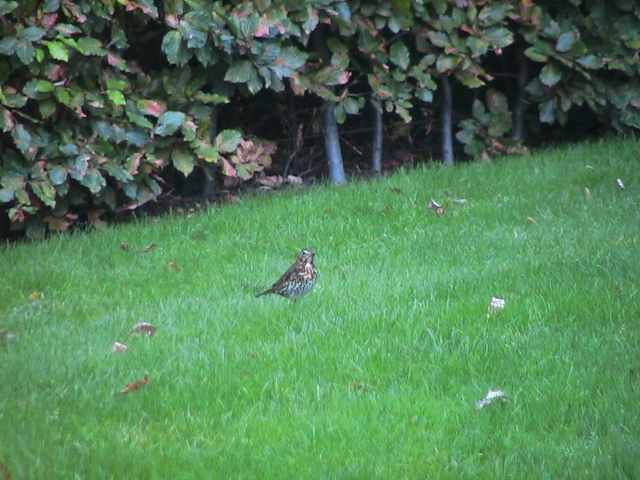
Thrush sp. (Photo: Ken Murray)
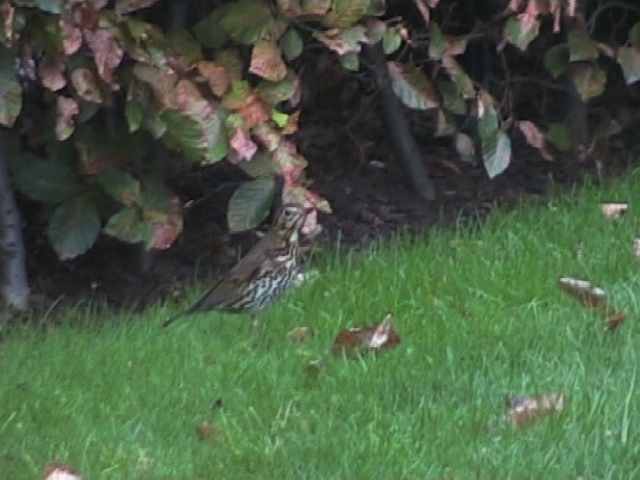
Thrush sp. (Photo: Ken Murray)
In conclusion, 2005 and 2006 where somewhat lacking in volume compared to previous years. Accepting that the respective breeding successes and weather system variables might not have been advantageous to migration, it was our opinion that the lighting reduction of c.50% overnight, coupled with a distinct lack of mainstay invertebrates (i.e. Cranefly), which are light-attracted, were the real material differences, especially in 2006. Nevertheless, the monitored site area to date (c.6 acres) has demonstrated that, light willing, it had the capacity to attract and sustain an amazingly high incidence of regular/scarce migrants that has no known urban comparison in the UK. What made the site so exciting and the birding so incredible is that on paper it should be devoid of migrant life, given that these small window-box areas of cover are surrounded, encased, and indeed canyoned, by the UK's tallest blocks of glass, concrete and steel. Also the fact that eight or more national rarities should occur in Canada Square alone in a five-year period, not to mention the regular migrants, underlines the importance of this sensitive site.
2007/2008 has been an unmitigated disaster! We managed 26 and 27 bird days respectively for the years, compared to 600 in 2004! Unsympathetic lighting, weather systems and breeding failures provide a list of variables to ponder.
To make any comparisons, albeit with differences, one has to cross the Atlantic and consider Robert DeCandido's PhD entitled "Autumn 2004: Visible Night Migration of Birds at the Empire State Building (ESB), New York City, New York". This is a detailed 25-page account of monitoring 'flyover' nocturnal avian migrants. This was done from the observation platform of the Empire State Building, at an elevation of 1050 feet, from mid-August through to mid-November, from sunset to 11:45pm. DeCandido's sightings were purely flyovers, as the nearest cover is Central Park, around 1.5 miles away. This is unlike the Canary Wharf complex, which has secondary guide lighting at street/ground level within the shrubberies that surround the towers, therefore presenting the VIPs with food and cover during their transient tenancy. Just like the ESB survey, which primarily attracted New-World wood warblers, flycatchers and their allies, Canary Wharf mirrors the same groups, albeit with their Old-World equivalents.
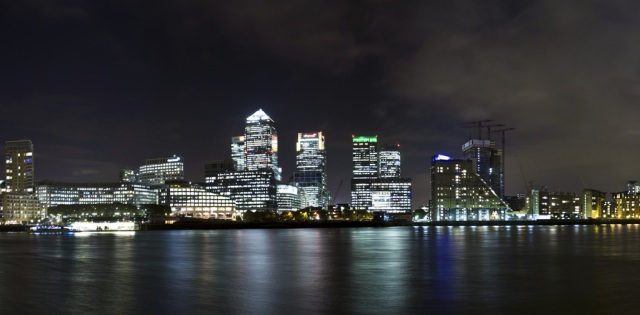
Canary Wharf at night (Photo: flickr user Poolski)
A footnote to the above, between 25th and 29th May: I holidayed in Boston USA and during my stay I visited the financial centre, which was predominantly 'sky-scrapered'. During lunch at the foot of a particular bank, my wife and I were seated by a small, terraced marbled shrub area that enjoyed relatively scant cover. We observed two Ovenbirds, two Yellowthroats and several White-throated Sparrows. I believe it certainly re-affirmed a correlation between migrant birds, skyscrapers and 'white' night-lighting.
A final comment on the post-9/11 security issue, as mentioned previously: the three main monitors were supplied with lapel badges that clearly showed their name with photo ID. Nevertheless such is the sensitivity that we were frequently challenged by the estate security, the tenant's security, and the Metropolitan Police whenever we appeared to aim our optics/cameras at the trees in front of the buildings. On one occasion there was a complaint registered between a tenant and the estate management, which resulted in a recommendation from our permit providers that this should be avoided. To say that this was something that was not going to be jeopardised at any cost, would be an understatement. Thus compliance was always absolute!
With the prevailing CO2 concerns and the corresponding reduction of lighting ensuring a now much-diminished return, we discussed the site's now limited attraction with management, whereupon they have relaxed their previous concerns, and allowed publication of this account subject to their agreement.

